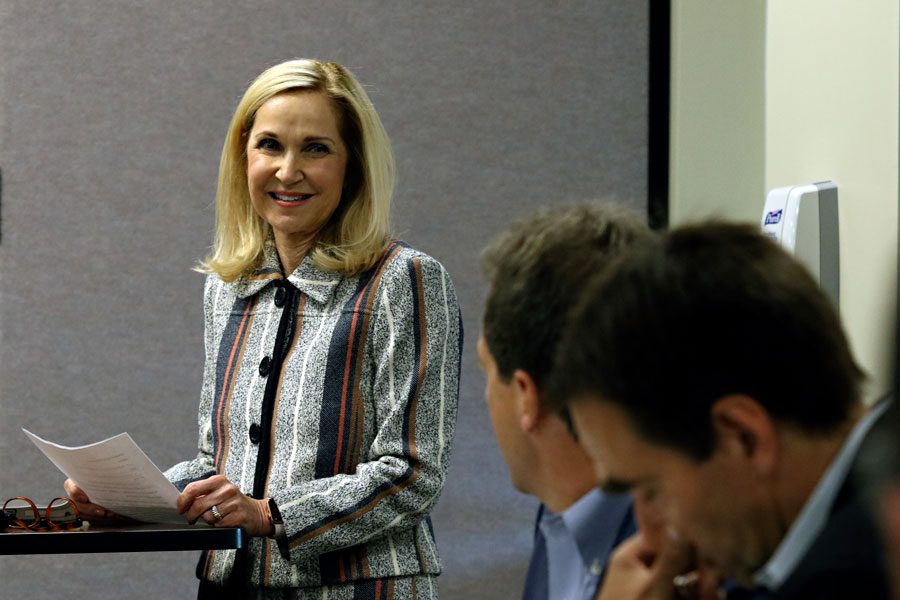In response to nurses organizing an effort to unionize, Kalispell Regional Healthcare CEO and President Pamela Robertson issued a memo respecting the rights of employees to seek outside representation while stating that it’s the wrong approach.
The memo also said the hospital values the “significant” and “often tireless” contributions of nurses and other employees.
In her Aug. 28 message to employees, Robertson cited a Flathead Beacon story publicizing nurses’ grievances.
“While we disagree with several of the points raised in the article, we recognize that we — like most all health care providers today — face important challenges,” Robertson wrote. “KRH’s leadership team is actively engaged, working to address these challenges. And in doing so, we will continue to ask for, and depend upon, engagement and support from our entire nurse and employee team.”
“Our position is that bringing in an outside third-party is not the right approach — for our employees or our patient care mission,” she continued. “Instead, we value our direct relationship and collaboration with our employees. We believe it is in all of our best interests to continue working together to meet our challenges and embrace our opportunities.”
Organizing nurses cite an array of grievances related to unfair wages, loss of benefits, unsafe work conditions, low morale and suboptimal patient environments. They have been in contact with the Teamsters and Montana Nurses Association about unionizing and are moving forward with the Teamsters.
Other grievances include poor health insurance, lack of a process to air grievances with representation, and staff distributions that leave individual nurses isolated and stretched thin, potentially jeopardizing patients’ safety.
The unionization effort gained momentum following news earlier this year of a lawsuit filed by the hospital’s physician network’s chief financial officer and a federal investigation into KRH for an allegedly illegal scheme of improper payments to certain physicians, and the hospital’s efforts to trim costs as it faces a pending $21.5 million settlement, according to interviews with nurses.
Nurses say they and other non-physician employees at the hospital have unfairly felt the brunt of cost-cutting efforts stemming from a settlement and allegations that have nothing to do with them.
Organizers are currently gathering signatures, needing 30 percent of nursing staff to express interest in advancing a union application. The next step would be to submit the application to the National Labor Relations Board. If approved, an election would then be held, with over 50 percent of the vote required to unionize and begin negotiations.
“We want to get our voices out there,” a nurse said. “We’re tired of having no voice.”
“Nurses are the ones taking care of people for 12 hours at a time, with barely any breaks, the ones trying to make do without extra staff,” the nurse continued. “I feel our community isn’t aware of what’s going on. And I don’t feel like they’re aware that (the hospital is) cutting nursing staff benefits.”
Nurses from the HealthCenter, North Valley Hospital and clinics have expressed interest in unionizing, in addition to those at Kalispell Regional Medical Center, according to organizers. They say their long-term goal is to improve work conditions beyond nurses, extending to certified nursing assistants, techs, housekeepers, secretaries, phlebotomists and other hospital employees.
Robertson’s message sought to address all hospital employees.
“At Kalispell Regional Healthcare, we value the significant, often tireless, contributions that our nurses and employees make in supporting the delivery of high quality patient care,” Robertson said in her memo. “We also respect the rights of our employees to either support or oppose representation by an outside labor union.”
Robertson noted that “many members of the executive leadership team are new to the organization and getting up to speed as quickly as possible on specific employee concerns.”
“Through that process, we have tried to open lines of communication and invite feedback and ideas,” she continued. “We are committed to maintaining a place that is great for our employees and patients. We will continue to communicate with you on many topics and we invite you to discuss any concerns you have with your leaders.”
